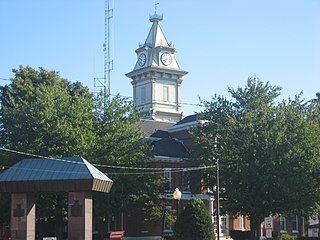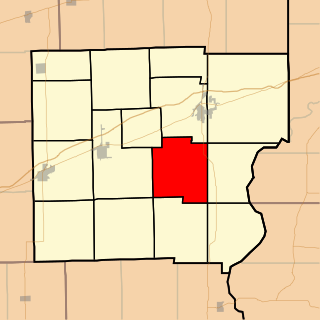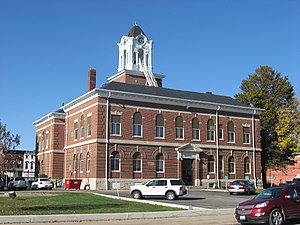
Wabash County is a county located in the U.S. state of Illinois. According to the 2020 census, it had a population of 11,361. Its county seat is Mount Carmel. It is located in the southern portion of Illinois known locally as "Little Egypt".

Richland County is a county located in the U.S. state of Illinois. According to the 2020 United States census, it had a population of 15,813. Its county seat is Olney.

Piatt County is a county in Illinois. According to the 2020 United States Census, it had a population of 16,673. Its county seat is Monticello.

Marshall County is a county located in the U.S. state of Illinois. According to the 2020 census, it had a population of 11,742. Its county seat is Lacon.

Fayette County is a county located in the U.S. state of Illinois. As of the 2020 census, the population was 21,488. Its county seat is Vandalia, the site of the Vandalia State House State Historic Site. Ramsey Lake State Recreation Area is located in the northwestern part of this county.

Edwards County is a county located in the U.S. state of Illinois. As of the 2020 census, the population was 6,245. Its county seat is Albion.

Cumberland County is a county located in the U.S. state of Illinois. As of the 2020 census, the population was 10,450. Its county seat is Toledo.

Crawford County is a county located in the U.S. state of Illinois. As of the 2020 census, the population was 18,679. Its county seat is Robinson.

Martinsville is a city in Clark County, Illinois, United States. The population was 1,118 at the 2020 census.

Westfield is a village in Westfield Township, Clark County, Illinois, United States. The population was 536 at the 2020 census, down from 601 at the 2010 census.

Anderson Township is one of fifteen townships in Clark County, Illinois, USA. As of the 2020 census, its population was 460 and it contained 183 housing units.

Auburn Township is one of fifteen townships in the center of Clark County, Illinois, USA. As of the 2020 census, its population was 230 and it contained 114 housing units.

Casey Township is one of fifteen townships in Clark County, Illinois, USA. As of the 2020 census, its population was 3,459 and it contained 1,705 housing units. Casey Township changed its name from Cumberland in September 1876.

Darwin Township is located along the Wabash River in eastern Clark County, Illinois, USA. As of the 2020 census, its population was 347 and it contained 148 housing units. The township was named for the village of Darwin, which was named for the English scientist, Charles Darwin.

Dolson Township is one of fifteen townships in Clark County, Illinois, USA. As of the 2020 census, its population was 353 and it contained 204 housing units.

Johnson Township is one of fifteen townships in Clark County, Illinois, USA. As of the 2020 census, its population was 355 and it contained 154 housing units.

Marshall Township is one of fifteen townships in Clark County, Illinois, USA. As of the 2020 census, its population was 4,581 and it contained 2,144 housing units.

Martinsville Township is one of fifteen townships in Clark County, Illinois, USA. As of the 2020 census, its population was 1,542 and it contained 727 housing units.

Parker Township is one of fifteen townships in Clark County, Illinois, US. As of the 2020 census, its population was 167 and it contained 107 housing units.

Wabash Township is one of fifteen townships in Clark County, Illinois, USA. As of the 2020 census, its population was 2,081 and it contained 966 housing units.




























